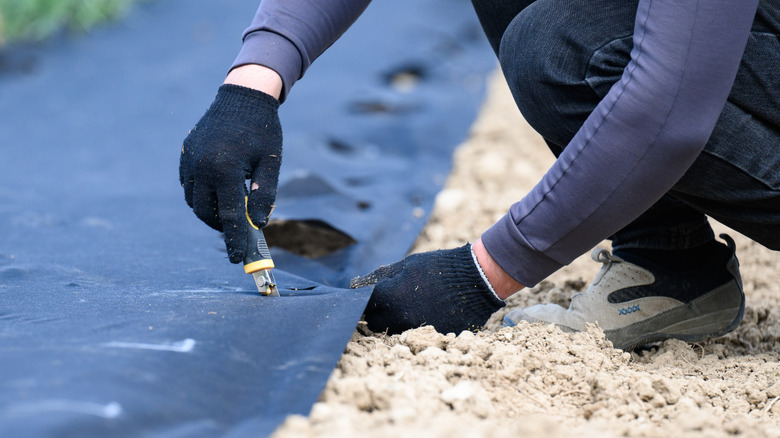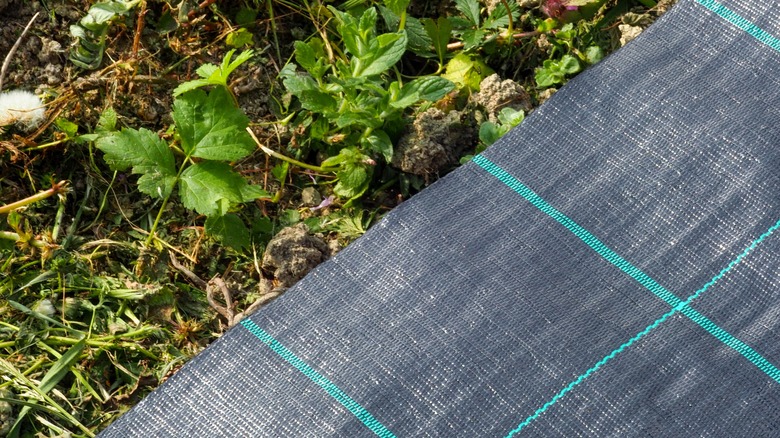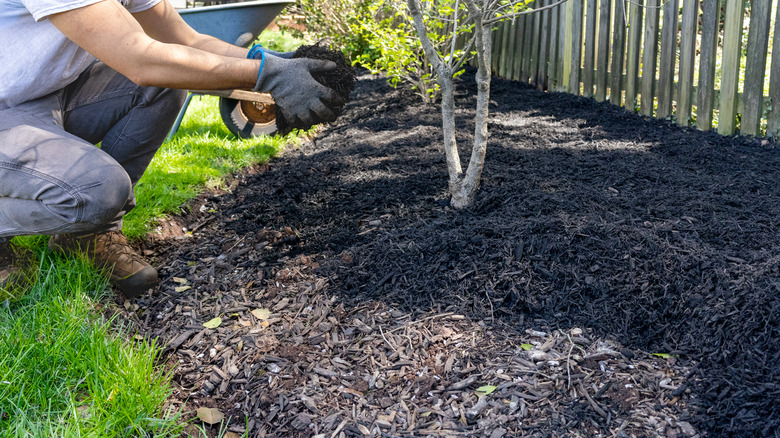The One Place You Want To Make Sure You Avoid Using Landscape Fabric And Why
Landscape fabric seems like a brilliant invention. Usually made from black- or gray-colored woven mesh, it's a barrier to weed growth that lets gardeners swap out pesticides for a material that can supposedly last for years. But if you see a tutorial that involves putting landscape fabric around the roots of a tree and then covering the whole area with mulch, think twice before replicating the technique. The one place you never want to put it is around the roots of trees and other plants you want to thrive. If you already have landscape fabric, use it on places where it can be watched closely and swapped out when needed, and try more earth-friendly alternatives around your trees.
If it's placed around the roots of trees or shrubs, the petroleum-sourced material that makes up many landscape fabrics (often it's polypropylene or polyethylene) eventually deprives them of the natural resources they need to stay healthy, like oxygen, moisture, and organic material. A downside to using landscape fabric is that dirt tends to clog its holes over time, so what starts out as a permeable cover eventually keeps air and water from reaching the soil and roots. Experienced gardeners will advise that as convenient as the material sounds, it's no substitute for a good mulch and a vigilant weed control practice.
Don't use landscape fabric around tree roots
As tempting as it may be to spread readily available fabric around the base of your tree and cover it with mulch as you may have seen pro landscapers do, it's actually best to keep landscape fabric far away from tree roots. Blanketing the soil around plants with the fabric keeps water out of the soil and stops gas exchange between the soil and the air around it, disrupting a process that the soil's beneficial microbes rely on.
Covering the landscape fabric with mulch is also a mistake. This cancels out the benefits of organic mulches, since their nutrients can't permeate the barrier to enrich the soil. Trapped above the fabric, the mulch decomposes without filtering down near the roots, where it could be feeding helpful earthworms.
The mulch above the fabric can ironically become a breeding ground for the weeds you may be trying to keep out; invasive seeds can be blown into the mixture, and as the mulch breaks down, it makes a compost that can feed them. After about a year, the problem can get worse and the stubborn weeds can even breach the barrier. To avoid these risks, landscape fabric should be kept to places where it can be regularly replaced. Especially if you can find non-plastic landscape fabric, this type of barrier can be safe to use in your vegetable garden instead of around a tree you hope to preserve for generations.
Landscape fabric alternatives for your garden
The good news is there are alternatives with weed-fighting properties you can use in place of landscape fabric around trees and plants. One option is simply to use mulch alone. If you make sure to spread a thick layer of a course type that lets air and water through, it will keep the tree healthy while performing the same function that people turn to landscape fabric for in the first place — preventing weed seeds from getting the sunlight they need to germinate. Pine needles and fallen leaves, which may already be lying around the yard, are some of the best ingredients to use in a DIY mulch.
A number of household staples can also stand in for landscape fabric and offer a boost of protection against seeds: Try placing a layer of plain cardboard or newspaper under the mulch, both of which dissolve into the soil over time instead of getting clogged and isolating the soil beneath them. Not only are these options budget-friendly, but they also offer food to the earthworms that help aerate the dirt. A word of caution to keep in mind if you're using cardboard or newspaper is to avoid glossy paper or coated cardboard — this way, the material will completely break down and help rather than hinder soil health.


